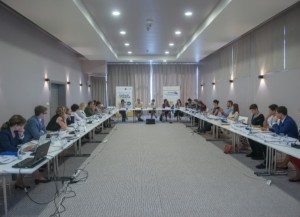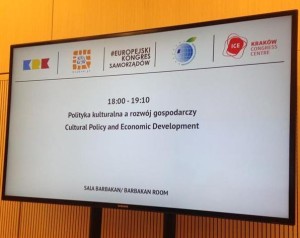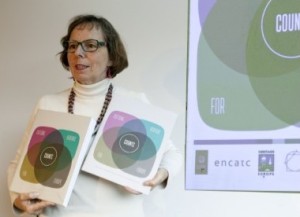
Claire Giraud-Labalte, member of the CHCFE Steering Committee on behalf of ENCATC and chair of the ENCATC Thematic Area Chair of “Understanding Heritage”
The results of the Cultural Heritage Counts for Europe project were presented to the Reflection Group “EU and Cultural Heritage” during their meeting held from 23-25 September in Luxembourg. Reflection group member, Claire Giraud-Labalte, member of the CHCFE Steering Committee, ENCATC Thematic Area Chair of “Understanding Heritage” and ENCATC Ambassador, was invited to present the project’s final publication and key findings along with Piet Jaspaert, Vice-President, Europa Nostra and member of the CHCFE Steering Committee. With an audience of representatives from European institutions, UNESCO, European heritage institutes and monuments and heritage networks, it was crucial to share the project results to ensure key players in policy and heritage have the resource to provide concrete evidence of the impact of cultural heritage on the economy, society, culture and the environment.
This meeting was also the opportunity for participants to discuss the importance to cultural heritage and international relations, as well as the international dimensions inherent to local heritage, be it historical or contemporary. The 3-day programme included expert testimony from UNESCO, the Council of Europe, the European Investment Bank, European heritage and cultural networks, and national governments. Participants were also invited to study visits to discover local heritage and meet with operators in the field.
The Reflection group “EU and cultural heritage” was established during the Belgian Presidency of the Council of the European Union in 2010. Its mission, according to the Declaration of Bruges, is to study the impact on cultural heritage of EU legislation and policies and to ensure ways so that the potential of cultural heritage is better accentuated and disseminated. The Reflection Group on “EU and Cultural Heritage” composed of the representatives of EU Members States and also of European networks active in the field of cultural heritage.
The forum ‘Cultural Heritage Works for South East Europe’ took place on 23 September 2015, in Igalo, Montenegro. This event brought together public and civil society stakeholders from the European Union (EU) and South East Europe (SEE) to discuss the real policy momentum for heritage and formulate concrete proposals on the new phase of regional cooperation in this field. The forum was followed by the 12th meeting of the Regional Cooperation Council Task Force on Culture and Society (RCC-TFCS) the next day. On this occasion, the results and recommendations of the ‘Cultural Heritage Counts for Europe’ project were presented. Sneška Quaedvlieg-Mihailović, Secretary General of Europa Nostra, also representing the European Heritage Alliance 3.3., participated in the events.
The forum was opened by: Asja Drača Muntean, TFCS Chair and Assistant Minister of Culture and Information in the Republic of Serbia; Sanjin Arifagić, SEE2020 Coordinator at the Regional Cooperation Council; Wenceslas de Lobkowicz, Advisor at the DG for Neighbourhood and Enlargement Negotiations of the European Commission; and Sneška Quaedvlieg-Mihailović, Secretary General of Europa Nostra and member of the Cultural Heritage Counts for Europe (CHCFE) Steering Committee.
Sneška Quaedvlieg-Mihailović noted the evident policy shifts caused by the increased recognition of the importance, impact and value of cultural heritage in the EU and highlighted the need to include the SEE region in these developments through strengthened participatory approaches. She also underlined the priority of tackling the ongoing refugee crisis in Europe and advocated the crucial role that heritage can play in fostering regional and intercultural dialogue. Finally, the Secretary General of Europa Nostra, also acting on behalf of the European Heritage Alliance 3.3, emphasised the significance of the initiative in organising a European Year of Cultural Heritage in 2018, thus providing a target to aim for to show that cultural heritage indeed works for Europe and SEE.
The meeting featured three thematic panel discussions: Cultural Heritage Counts for (South East) Europe (moderated by Brian Smith, Secretary General of the European Association of Historic Towns and Regions and member of the CHCFE Steering Committee); Participatory governance of cultural heritage in the EU and its implications in SEE (moderated by Sneška Quaedvlieg Mihailović); and Cultural Heritage in SEE: towards a new momentum for regional cooperation (moderated by Wenceslas de Lobkowicz).
“The participants agreed to open a new phase of the Ljubljana Process by reaching out to other stakeholders with a view to building stronger partnerships for the benefit of cultural heritage in South East Europe. This new phase of regional cooperation should duly reflect the recent important EU policy developments which recognise heritage as a strategic resource and a driver of sustainable development in Europe and which promote an integrated approach to cultural heritage at all levels of governance (local, national, regional and European). The focus should be to ensure effective implementation of these newest policy developments throughout the region,” reads the meetings’ Conclusions.
“The Task Force on Culture and Society is encouraged to promote a holistic approach to measuring the impact of cultural heritage and in that respect the key findings and recommendations of the ‘Cultural Heritage Counts for Europe’ report could serve as a useful reference in the longer term. The TFCS is also encouraged to promote the value of and the need for participatory governance in cultural heritage which seeks to ensure the appropriate involvement of all relevant stakeholders, including communities, civil society organisations, research circles and the business sector,” the Conclusions state.
The meeting gathered delegates from the Regional Cooperation Council and the European Commission, TFCS members from Albania, Bosnia and Herzegovina, Croatia, Greece, Kosovo, Moldova, Montenegro and Serbia, and representatives from organisations based in various countries – Albania (Cultural Heritage without Borders), Bosnia and Herzegovina (Balkans Museum Network), Montenegro (Expeditio), the United Kingdom (Heritage Europe and North of England Civil Trust), Romania (Architecture Restoration Archaeology) and Serbia (Europa Nostra Serbia) – the majority of which are also part of Europa Nostra’s network.
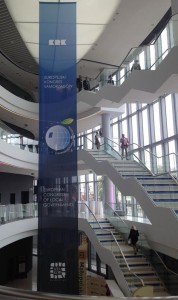 Kate Pugh, member of the CHCFE Steering Committee was invited to share her expertise at the European Congress of Local Governments held in Krakow, Poland from 4-5 May 2015. The two-day event was attended by more than 1,000 guests from across Europe.
Kate Pugh, member of the CHCFE Steering Committee was invited to share her expertise at the European Congress of Local Governments held in Krakow, Poland from 4-5 May 2015. The two-day event was attended by more than 1,000 guests from across Europe.
As one of five concurrent sessions, the Congress’ discussion panel “Cultural Policy & Economic Development” took a closer look at culture and creative industries as one of the fastest developing areas of economy. Investments in culture ensure economic development and increase competitiveness in the regions as well as guarantee the intellectual development of society. Furthermore, culture has a positive influence on the attractiveness of cities and regions. Invited panelists presented their views on how to unlock the potential and variety of culture in regions the the strategies regional cultural policy makers should follow.
Speaking on the panel as Chief Executive of The Heritage Alliance, Ms. Pugh focused her address on the historic environment, rather than performing and visual arts described by other contributors. The importance of heritage assets to the tourism industry and more recently the links to the creative and cultural industries, both of which are fast growing sectors in the UK economy. Moreover, she stressed the importance of collecting and managing data to support evidence-based policy making to create a framework in which all stakeholders can thrive and provided the Cultural Heritage Counts for Europe project as once example or providing such evidence. “A European Congress with an audience of 1,000 was exactly the right platform for alerting so many local government leaders from across EU Member States to the importance of gathering evidence of impact, especially in view of the differences noted in the CHCFE report,” says Kate Pugh.
The results of the Cultural Heritage Counts for Europe project will be presented on 12 June in Oslo during the project’s final conference.
DISCUSSION PANEL “Cultural Policy and Economic Development”
5 May 2015 // 18:00 – 19:10 // Krakow, Poland
Moderator:
Jerzy Fedorowicz, Member, Parliament, Poland
Speakers:
Krzysztof Dudek, Director, National Centre for Culture, Poland
Martha Mary Friel, Programme Manager in Tourism and Local Development, Research Center CSS-EBLA, Italy
Valentyna Kovalenko, Chairman, Cherksy Regional Council, Ukraine
Michael Moglia, President of the Committee of Finances, Human Resources, Administration and Communication, Regional Council Nord-Pas-de-Calais, France
Kate Pugh, Chief Executive, The Heritage Alliance, United Kingdom
Elisabeth Vitouch, President fo the Committee for European and Internatinal Affairs, Vienna Provincial Parliament, Austria
Commentator:
Oskana Prishchepova, President, The Kaliningrad Regional Public Organisation “Woman’s World”, Russia
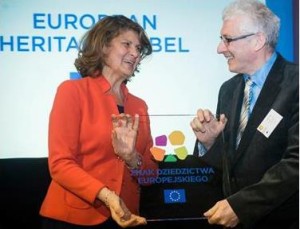 On 15 April, members of the CHCFE Steering Committee attended the European Heritage Label (EHL) Award Ceremony. Held at the Bibliothéque Solvay in Brussels, the ceremony commemorated the sixteen heritage sites from 10 countries chosen to receive the label in 2015. During his opening speech, Tibor Navracsics, European Commissioner for Education, Culture, Youth and Sport said: “Heritage is a vital part of our collective identity as Europeans. It roots us firmly in our past, but it also helps us to shape our vision of the Europe of the future. It is a source of inspiration for thinkers and artists and the driver of our cultural and creative industries.” In front of an audience of policy makers, culture and heritage professionals, and representatives of European networks, Silvia Costa, MEP and Chair of the Committee on Culture and Education handed out the Award plaques to each winner.
On 15 April, members of the CHCFE Steering Committee attended the European Heritage Label (EHL) Award Ceremony. Held at the Bibliothéque Solvay in Brussels, the ceremony commemorated the sixteen heritage sites from 10 countries chosen to receive the label in 2015. During his opening speech, Tibor Navracsics, European Commissioner for Education, Culture, Youth and Sport said: “Heritage is a vital part of our collective identity as Europeans. It roots us firmly in our past, but it also helps us to shape our vision of the Europe of the future. It is a source of inspiration for thinkers and artists and the driver of our cultural and creative industries.” In front of an audience of policy makers, culture and heritage professionals, and representatives of European networks, Silvia Costa, MEP and Chair of the Committee on Culture and Education handed out the Award plaques to each winner.
The European Heritage Label sites were chosen by an independent selection panel because they are about much more than just aesthetics. They go beyond to celebrate and symbolise European integration, ideals, values and history. The sites were also carefully selected for the activities they offer in order to bring the European Union and its citizens closer together. This includes organising a wide range of educational activities, especially for young people. Together, the sites can give visitors a real feel for the breadth and scale of what Europe has to offer and what it has achieved.
“For those of us spending most of our time at a computer screen, to hear the inspiring stories and take in the personal energy of the European Heritage Label winners more than justified our behind-the-scenes work on policy and practice with the Cultural Heritage Counts for Europe project. The winners from across Europe fully demonstrate yet again that the diversity of our cultural heritage is one of Europe’s greatest assets,” said Kate Pugh, member of the CHCFE Steering Committee and Chief Executive of The Heritage Alliance in the United Kingdom.
“The European Heritage Label Ceremony was a very inspiring evening which invited us to interpret cultural heritage widely by embracing not only historical monuments and sites but also historical events and personalities as an integral part of our common European cultural heritage. We congratulate the sixteen sites who received the Label for their commitment to promote the European idea and ideal,” added Sneška Quaedvlieg – Mihailovic, Secretary General of Europa Nostra who is leading the CHCFE project.
The European Heritage Label began as an initiative of several national governments to improve knowledge of European history, as well as the role and values of the EU. It was formally established in 2011 and the first selection of sites took place in 2013.
Learn more about the 16 awarded sites and about the European Heritage Label: http://ec.europa.eu/programmes/creative-europe/actions/heritage-label/index_en.htm

